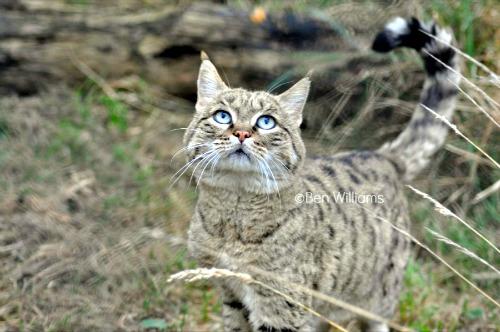- Head Body Length: 47-74 cm (18.5-29″)
- Tail Length: 21-36 cm (8.6-14″)
- Weight: 2-6 kg (4.4-13 lbs)
Distribution
The Asiatic Wildcat Felis lybica ornata occurs from the eastern Caspian region, north to Kazakhstan, into Pakistan and western India, western China and Mongolia. They are also known as Asian steppe cats or Indian desert cats.
The Caucasus mountain range at the border of Europe and Asia is the transitional zone for wildcats. The European Wildcat F. silvestris is found to the north and west, while the Asiatic wildcat inhabits the semi-desert areas near the Caspian Sea in the south and east. Snow depth limits their northern range boundaries.
In India, they have been reported in Sariska Tiger Reserve as well as other wildlife sanctuaries in western states.
Ecology
The background colour of these cats is pale sandy gray in Pakistan and India, while the cats of Central Asia are more greyish-yellow or reddish.
Their spot pattern is variable and markings can be large, small, distinct, blurred, black, brown or greyish. Spots are sometimes fused to form unbroken lines, and one or two dark bands circle the upper fore and hind legs. The long, thin tail is spotted near the base but ringed towards the black tipped end. Underparts are whitish and unspotted. The ears have a yellowish-buff band on the back and a characteristic tuft of dark hair on the tip. Paler forms live in drier areas while more heavily spotted and striped forms occur in more humid, wooded areas.
Unlike the forest dwelling wildcats of Europe, these cats are more often associated with drier scrub desert up to 3,000 m. They inhabit thickets of thorn scrub in western deserts, and bush and reeds along lakes in Kazakstan. They are not found in the steppe grasslands or alpine steppes of Mongolia.
Preferring to live near water, these cats can live year round in waterless desert, relying on prey species for their moisture requirements. Their main prey is the desert gerbil, with hares, birds, small rodents, insects and reptiles making up the balance.
Asiatic wildcats are frequently observed in the daytime. They frequently use rock crevices or burrows dug by other animals. In Pakistan they reportedly shelter underground or in dense cover during the heat of the day.
A study in western India found the breeding site of the Asiatic Wildcat to be a den with three openings facing different directions. It was situated under a bush, surrounded by colonies of gerbils. Such breeding sites provide enough food for the young as well as protection from enemies.
Conservation
As with all wildcat species, Asiatic Wildcats face considerable threat from habitat loss and poaching. Reclaiming wastelands in the name of development has resulted in the destruction of much of their habitat in India.
These cats can be found near cultivated areas and human settlements, which increases cross-breeding with feral domestic cats. Hybridization with feral domestic cats has been reported from Pakistan, India and Central Asia.
In the past, Asiatic Wildcats were heavily trapped for their fur, although at present there is little international trade in their pelts. In 1979, traders declared stocks of 41,845 pelts for an export amnesty. Asiatic Wildcat pelts also formed a major portion of the small cats’ skin seizures in India from 1982-1999.
No detailed ecological studies exist on Asiatic Wildcats and the available information on their ecology and distribution seems to be based on random, opportunistic observations.
A new publication on Asiatic Wildcat from India Asiatic Wildcat was photographed from two states of India i.e. Rajasthan and Madhya Pradesh. This was the first photographic record of the species from Madhya Pradesh.
Asiatic Wildcat was photographed from two states of India i.e. Rajasthan and Madhya Pradesh. This was the first photographic record of the species from Madhya Pradesh.
http://threatenedtaxa.org/
Back to the main Wildcat page.

Talk to Us!